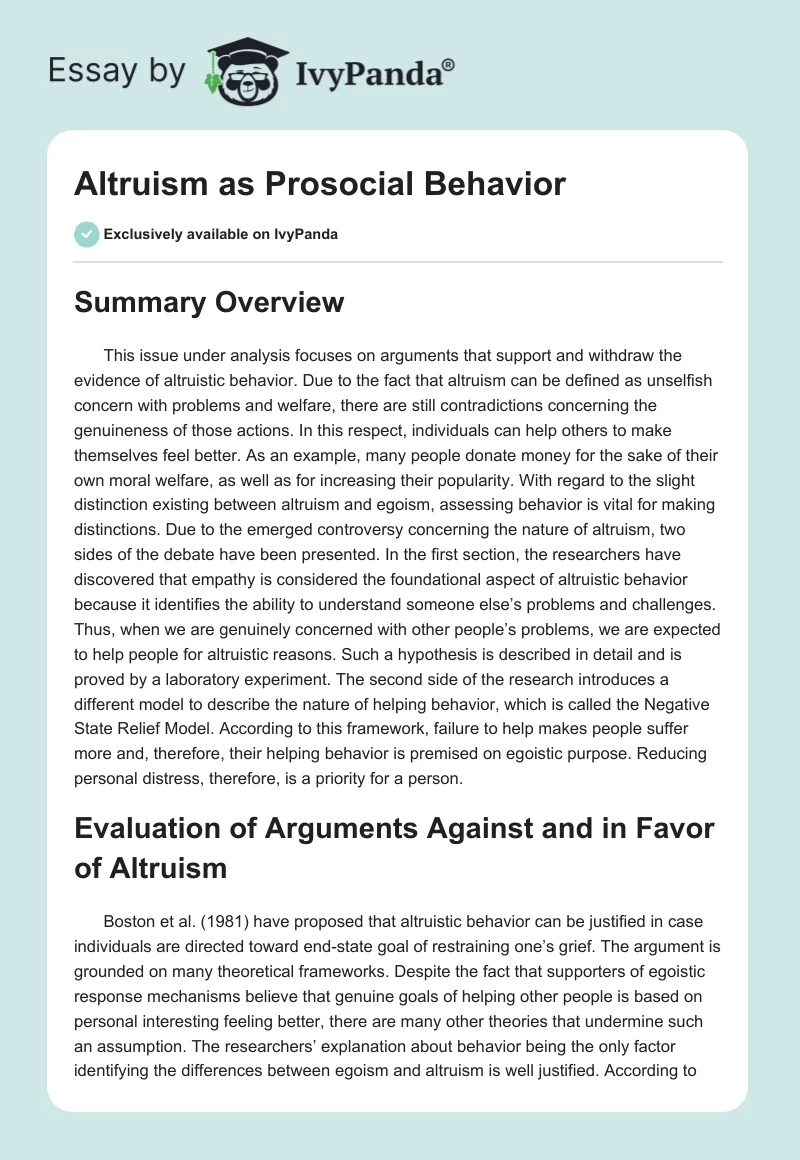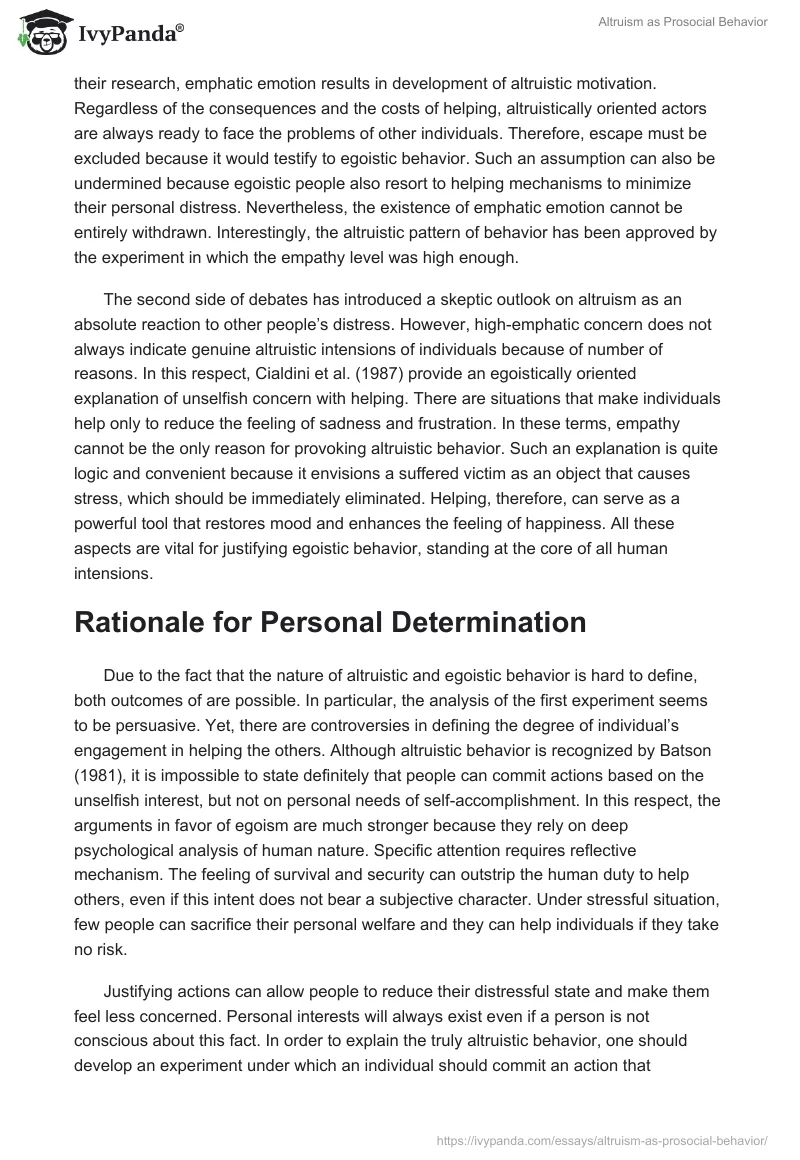Summary Overview
This issue under analysis focuses on arguments that support and withdraw the evidence of altruistic behavior. Due to the fact that altruism can be defined as unselfish concern with problems and welfare, there are still contradictions concerning the genuineness of those actions. In this respect, individuals can help others to make themselves feel better. As an example, many people donate money for the sake of their own moral welfare, as well as for increasing their popularity. With regard to the slight distinction existing between altruism and egoism, assessing behavior is vital for making distinctions. Due to the emerged controversy concerning the nature of altruism, two sides of the debate have been presented. In the first section, the researchers have discovered that empathy is considered the foundational aspect of altruistic behavior because it identifies the ability to understand someone else’s problems and challenges. Thus, when we are genuinely concerned with other people’s problems, we are expected to help people for altruistic reasons. Such a hypothesis is described in detail and is proved by a laboratory experiment. The second side of the research introduces a different model to describe the nature of helping behavior, which is called the Negative State Relief Model. According to this framework, failure to help makes people suffer more and, therefore, their helping behavior is premised on egoistic purpose. Reducing personal distress, therefore, is a priority for a person.
Evaluation of Arguments Against and in Favor of Altruism
Boston et al. (1981) have proposed that altruistic behavior can be justified in case individuals are directed toward end-state goal of restraining one’s grief. The argument is grounded on many theoretical frameworks. Despite the fact that supporters of egoistic response mechanisms believe that genuine goals of helping other people is based on personal interesting feeling better, there are many other theories that undermine such an assumption. The researchers’ explanation about behavior being the only factor identifying the differences between egoism and altruism is well justified. According to their research, emphatic emotion results in development of altruistic motivation. Regardless of the consequences and the costs of helping, altruistically oriented actors are always ready to face the problems of other individuals. Therefore, escape must be excluded because it would testify to egoistic behavior. Such an assumption can also be undermined because egoistic people also resort to helping mechanisms to minimize their personal distress. Nevertheless, the existence of emphatic emotion cannot be entirely withdrawn. Interestingly, the altruistic pattern of behavior has been approved by the experiment in which the empathy level was high enough.
The second side of debates has introduced a skeptic outlook on altruism as an absolute reaction to other people’s distress. However, high-emphatic concern does not always indicate genuine altruistic intensions of individuals because of number of reasons. In this respect, Cialdini et al. (1987) provide an egoistically oriented explanation of unselfish concern with helping. There are situations that make individuals help only to reduce the feeling of sadness and frustration. In these terms, empathy cannot be the only reason for provoking altruistic behavior. Such an explanation is quite logic and convenient because it envisions a suffered victim as an object that causes stress, which should be immediately eliminated. Helping, therefore, can serve as a powerful tool that restores mood and enhances the feeling of happiness. All these aspects are vital for justifying egoistic behavior, standing at the core of all human intensions.
Rationale for Personal Determination
Due to the fact that the nature of altruistic and egoistic behavior is hard to define, both outcomes of are possible. In particular, the analysis of the first experiment seems to be persuasive. Yet, there are controversies in defining the degree of individual’s engagement in helping the others. Although altruistic behavior is recognized by Batson (1981), it is impossible to state definitely that people can commit actions based on the unselfish interest, but not on personal needs of self-accomplishment. In this respect, the arguments in favor of egoism are much stronger because they rely on deep psychological analysis of human nature. Specific attention requires reflective mechanism. The feeling of survival and security can outstrip the human duty to help others, even if this intent does not bear a subjective character. Under stressful situation, few people can sacrifice their personal welfare and they can help individuals if they take no risk.
Justifying actions can allow people to reduce their distressful state and make them feel less concerned. Personal interests will always exist even if a person is not conscious about this fact. In order to explain the truly altruistic behavior, one should develop an experiment under which an individual should commit an action that contradicts his/her interests. Such situations are quite rare, but their occurrence still takes place. The phenomenon proves that people can be endowed with the genuine desire to help because they are not fully aware of their subconscious mechanisms compelling them to do such actions. More importantly, as soon as they become more experienced, they can realize that their actions are motivated to reduce their problems or eliminate their sadness.
References
Batson, C. D., Duncan, B. C., Ackerman, P., Buckley, T., & Birch, K. (1981). “Is Emphatic Emotion a Source of Altruistic Motivation? Journal of Personality and Social Psychology. 40 (2), 378-388.
Cialdini, R. B., Shaller, M., Houlihan, D., Arps, K., Fultz, J., & Beaman, A. L. (1987). Empathy-Based Helping: Is It Selflessly or Selfishly Motivated. Journal of Personality and Social Psychology. 389-398.


